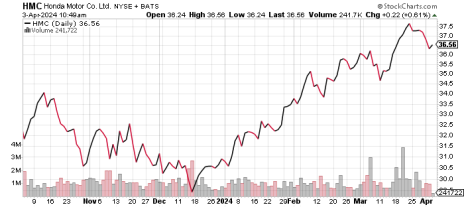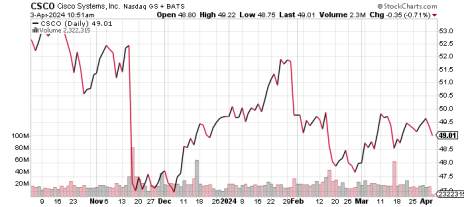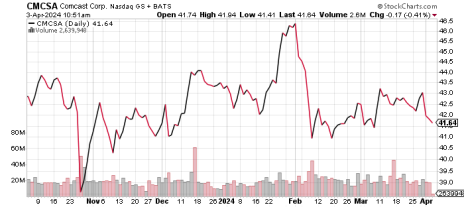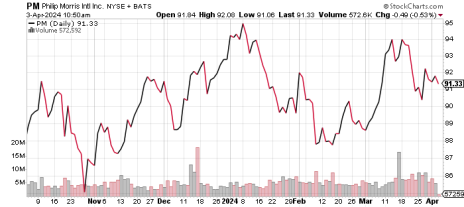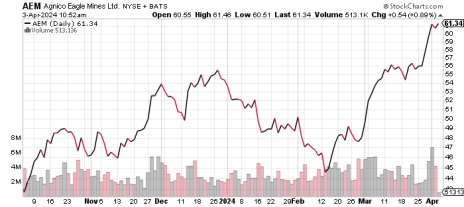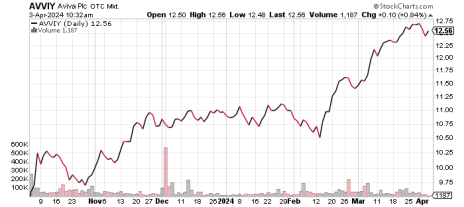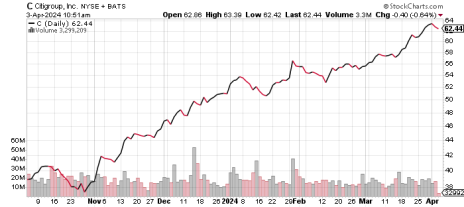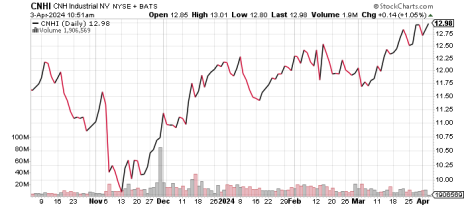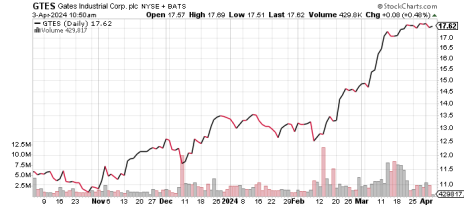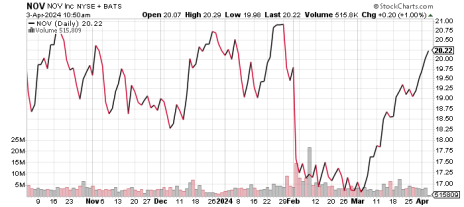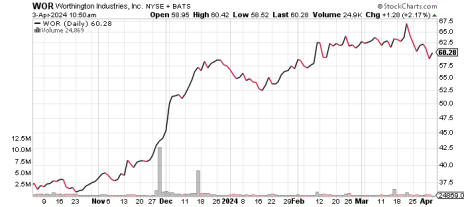Don’t look now, but value stocks are having a moment.
Since the stock market bottomed in late October, value stocks – as measured by the Vanguard S&P 500 Value Index Fund (VOOV) – are up 25.2%. OK, so that’s just shy of the 26.4% gain in the S&P 500 during that time, but while growth stocks have been stuck in the mud the last month – large-cap growth stocks are exactly flat since the beginning of March – value stocks are up 3%. It’s not pop-the-champagne-bottles kind of outperformance. But it is outperformance – something we’ve rarely seen from value stocks over the last decade-plus.
Hi, I’m Chris Preston – new Chief Analyst of Cabot Value Investor. I have been with Cabot for the last nine years and have served as Editor-in-Chief since 2018 and Chief Analyst of our Cabot Stock of the Week advisory for the past two years. I also co-host our weekly podcast, Street Check, with my brainy colleague Brad Simmerman and host our monthly webinars as well as our quarterly calls with Cabot Prime members.
Change can be difficult, especially when it involves your hard-earned money. So I don’t plan to upset the apple cart (is that still an expression?) too much. Bruce Kaser did an outstanding job making lemonade out of the value-investing lemons (to continue the fruit theme) that have prevailed in recent years. Now that the environment appears to be turning less sour for value investors, I’d like to continue Bruce’s work of uncovering undervalued gems.
That said, I’d like to add my own twist. While value stocks are finally gaining traction, growth is still king. Value stocks are up 60% in the last five years, which trails the 80% return in the S&P 500 during that time and is well off the 104.5% return in the Nasdaq. With the bull market in full swing, growth remains a hot commodity. So, my goal is to blend the two and seek growth at value prices. That means finding companies that are still growing revenue and earnings at a healthy clip but, for whatever reason, have become overlooked by the big institutions that run Wall Street – at least until recently.
Warren Buffett does this. Apple (AAPL), the quintessential growth stock of the last decade-plus, is by far his largest holding at 41.4% of the Berkshire Hathaway portfolio. He also holds much smaller positions in fellow Magnificent Seven stock Amazon (AMZN), fast-emerging Chinese electric vehicle giant BYD (BYDDY), and Brazilian digital banking platform Nu Holdings (NU). None of those are traditional value stocks, and yet they comprise nearly half the portfolio of the world’s foremost value investor.
Let’s strive to do the same. By fusing value with growth, we can take advantage of a market that has favored growth for years but also may be rediscovering its appetite for value. Expect more additions to our Growth & Income portfolio, which currently has just three holdings. In fact, my first growth-at-value-prices addition comes today, as we add Honda Motor Co. (HMC) to the Growth & Income Portfolio. The Japanese automaker grew sales by 33% in 2023, and yet HMC shares trade 18% below their 2011 peak.
New Addition: Honda Motor Co. (HMC)
The first car I ever bought was a Sapphire Blue Honda Civic. It had two doors; you had to manually roll the windows down with a lever; there was no button on the keychain to lock and unlock the doors – you had to stick the key in the lock and turn. And I loved it. Of course, at the time I was single, living in Washington, D.C., and needed a car – any car – to commute to my job at a residential real estate firm in northern Virginia. Once I moved to snowy Vermont and had kids, getting around in a two-door sedan with front-wheel drive quickly became untenable. But the Civic had served me well for more than a decade.
Soon, the Civic will be available as a hybrid. Technically, it already was – or a close facsimile of it, the “Honda Insight,” was until 2015. Later this year, however, the new Honda Civic Hybrid will go on sale, piggybacking on the success of Toyota’s Corolla Hybrid. In fact, Honda has found new life thanks to hybrids – i.e., cars that use both the traditional internal combustion engine and an electric, battery-powered motor. After years of declining sales, Honda was rejuvenated in 2023 thanks to hybrids.
The Japanese automaker sold 1.3 million cars last year, up 33% from 2022; a quarter of the cars it sold were hybrids, led by its popular CR-V sport utility vehicle (SUV) and Accord mid-size sedan. The CR-V was the best-selling hybrid in the U.S. last year, with 197,317 units sold. The Accord wasn’t far behind, with 96,323 sold. All told, Honda’s hybrid sales nearly tripled in 2023, to 294,000 units.
So, Honda is making the full pivot to hybrids, with the Civic soon to become the latest addition to its hybrid fleet. It’s part of a larger industry trend, where hybrids are gaining in popularity while the once-stoppable growth in pure electric vehicles has slowed. While Americans bought a record 1.2 million electric vehicles last year – up 46% from 2022 – hybrid sales surged 65%. When you include plug-ins, roughly 10% of all new cars purchased in the U.S. in 2023 were hybrids, vs. a 7.6% market share for pure electrics.
Investors have started gravitating more to the companies that sell them. Invariably, those are well-established, big-name car companies made famous by many decades of selling internal combustion engine vehicles; most aren’t ready to fully abandon their roots but want to tap into the surging national (and global) appetite for electric, so they instead are turning to hybrids as a compromise. As a result, these once-stodgy car companies are tapping into new revenue streams, and their share prices are surging accordingly.
That includes the likes of Toyota (TM) and Hyundai (HYMTF). But Honda (HMC) is the best value, trading at a mere 7.9x forward earnings estimates, 0.47 times sales, with an EV/EBITDA ratio of a microscopic 0.04. Trading in the mid-36s, shares have surged of late, up 18% in 2024 and 38% in the last year. And yet, they’re 18% below their peak above 44 in 2011.
Honda aims to boost sales by another 10% this year – a likely conservative estimate, considering its hybrid sales tripled last year and will only become an even bigger slice of the pie in 2024. Meanwhile, earnings per share are expected to come in at $4.20 in the current fiscal year (results will be reported on May 9), which would mark the company’s most profitable year since 2018 and a 47.7% improvement from fiscal ’23. EPS is expected to swell to $4.56 in fiscal ’25 (which technically started this week), and $4.89 in fiscal ’26.
Given Honda’s renewed, hybrid-assisted growth, HMC shares are cheap by every measure. And now they have momentum. Let’s add this stock to the Growth & Income (it also pays a 2.7% dividend yield!) Portfolio. I’m setting a price target of 45, which gives us 23% upside. BUY
Note to new subscribers: You can find additional commentary on past earnings reports and other news on recommended companies in prior editions and weekly updates of the Cabot Value Investor on the Cabot website.
Send questions and comments to chris@cabotwealth.com.
This Week’s Portfolio Changes
Honda Motor Company (HMC) – New Buy with a 45 price target
Last Week’s Portfolio Changes
Agnico Eagle Mines (AEM) – New BUY with a 75 price target
Barrick Gold (GOLD) – New SELL
Growth & Income Portfolio
Growth & Income Portfolio stocks are generally higher-quality, larger-cap companies that have fallen out of favor. They usually have some combination of attractive earnings growth and an above-average dividend yield. Risk levels tend to be relatively moderate, with reasonable debt levels and modest share valuations.
| Stock (Symbol) | Date Added | Price Added | 4/2/24 | Capital Gain/Loss | Current Dividend Yield | Price Target | Rating |
| Cisco Systems (CSCO) | 11/18/20 | 41.32 | 49.36 | 19.50% | 3.20% | 66 | Buy |
| Comcast Corp (CMCSA) | 10/26/22 | 31.5 | 41.81 | 32.70% | 3.00% | 46 | Hold |
| Honda Motor Co. (HMC) | 4/4/24 | 36.34 | 36.34 | --% | 2.70% | 45 | Buy |
| Philip Morris International (PM) | 9/18/23 | 96.96 | 91.46 | -5.70% | 5.60% | 120 | Buy |
Cisco Systems (CSCO) is facing revenue pressure as customers migrate to the cloud and thus need less of Cisco’s equipment and one-stop-shop services. Cisco’s prospects are starting to improve under a relatively new CEO, who is shifting Cisco toward a software and subscription model and is rolling out new products, helped by its strong reputation and entrenched position within its customers’ infrastructure. The company is highly profitable and generates vast cash flow. Its announced deal for Splunk will drain most of its cash hoard but we see this as being replenished relatively quickly.
There was no significant company-specific news in the past week.
CSCO shares were down 1% in the past week and have 35% upside to our 66 price target. Based on 2024 estimates, unadjusted for the Splunk acquisition, the valuation is reasonably attractive at 10.2x EV/EBITDA and 13x earnings per share. BUY
Comcast Corporation (CMCSA) – Comcast is one of the world’s largest media and entertainment companies. Its properties include Comcast cable television, NBCUniversal (movie studios, theme parks, NBC, Telemundo and Peacock), and Sky media. The Roberts family holds a near-controlling stake in Comcast. Comcast shares have tumbled due to worries about cyclical and secular declines in advertising revenues and a secular decline in cable subscriptions as consumers shift toward streaming services, as well as rising programming costs and incremental competitive pressure as phone companies upgrade their fiber networks.
However, Comcast is a well-run, solidly profitable and stable company that will likely continue to successfully fend off intense competition while increasing its revenues and profits, as it has for decades. The company generates immense free cash flow which is more than enough to support its reasonable debt level, generous dividend and sizeable share buybacks.
It was a rocky week for Comcast’s NBC News division, which hired and promptly fired controversial former Republican National Committee chairwoman Ronna McDaniel. High-profile on-air personalities Chuck Todd and Rachel Maddow sharply criticized the hire on NBC’s own airwaves, citing McDaniel’s role in attempting to overturn the 2020 election in favor of Donald Trump. The revolt was even louder on social media (as it always is). So, 80 hours after he hired her, NBCUniversal News Group boss Cesar Conde fired McDaniel, in a public whirlwind that seemed lifted from an episode of The Morning Show.
The incident is a black eye for NBC’s News division, and Comcast shares have slipped about 2.5% as a result. But the long-term damage is likely to be minimal, especially as the story fades into a distant memory in the coming weeks, glossed over by whatever controversy arrives next in today’s 24-hour news cycle.
The bright side? Comcast shares now have 8% upside to our 46 price target. HOLD
Philip Morris International (PM) – Based in Connecticut, Philip Morris owns the global non-U.S. rights to sell Marlboro cigarettes, the world’s best-selling cigarette brand. Cigarettes comprise about 65% of PMI’s revenues. The balance of its revenues is produced by smoke-free tobacco products. The cigarette franchise produces steady revenues and profits while its smoke-free products are profitable and growing quickly. The upcoming full launch of IQOS products in the United States, a wider launch of the IQOS ILUMA product and the recent $14 billion acquisition of Swedish Match should help drive new growth.
The company is highly profitable, generates strong free cash flow and carries only modestly elevated debt (at about 3.2x EBITDA) which it will whittle lower over the next few years. The share valuation at about 14x EBITDA and 14.4x per-share earnings estimates is too low in our view. Primary risks include an acceleration of volume declines and/or deteriorating pricing, higher excise taxes, new regulatory or legal issues, slowing adoption of its new products, and higher marketing costs. A strong U.S. dollar will weigh on reported results. While unlikely, Philip Morris could acquire Altria, thus reuniting the global Marlboro franchise.
There was no significant company-specific news in the past week.
PM’s shares were flat this past week and have 32% upside to our 120 price target. The shares offer an attractive 5.6% dividend yield. BUY
Buy Low Opportunities Portfolio
Buy Low Opportunities Portfolio stocks include a wide range of value opportunities. These stocks carry higher risk than our Growth & Income stocks yet also offer more potential upside. This group may include stocks across the quality and market cap spectrum, including those with relatively high levels of debt and a less-clear earnings outlook. The stocks may not pay a dividend. In all cases, the shares will trade at meaningful discounts to our estimate of fair value.
| Stock (Symbol) | Date Added | Price Added | 4/2/24 | Capital Gain/Loss | Current Dividend Yield | Price Target | Rating |
| Agnico Eagle Mines (AEM) | 3/25/24 | 56.31 | 61.49 | 9.20% | 2.60% | 75 | New Buy |
| Aviva (AVVIY) | 3/3/21 | 10.75 | 12.58 | 17.00% | 6.60% | 14 | Buy |
| Citigroup (C) | 11/24/21 | 67.28 | 62.18 | -7.60% | 3.30% | 85 | Buy |
| CNH Industrial (CNHI) | 11/30/23 | 10.74 | 12.84 | 19.60% | 3.70% | 15 | Buy |
| Gates Industrial Corp (GTES) | 8/31/22 | 10.72 | 17.62 | 64.40% | 0.00% | 20 | Buy |
| NOV, Inc (NOV) | 4/25/23 | 18.19 | 20.28 | 11.50% | 1.00% | 25 | Buy |
| Worthington Enterprises (WOR) | 2/6/24 | 57.13 | 59 | 3.30% | 1.10% | 73 | Buy |
Agnico Eagle Mines (AEM) is the world’s third-largest and likely the highest-quality and lowest-risk gold mining company. Its strategy of “proven geological potential in premier jurisdictions” appropriately describes its exclusive focus on quality mines in the legally safe countries of Canada, Mexico, Australia and Finland. In the past few years, Agnico has made several in-region acquisitions including Kirkland Lake in 2022 for $11 billion and Yamana Gold’s Canadian assets for $2.6 billion. The plan for the next five years is to fully integrate and improve these operations and grow production in its existing mines.
As the owner of some of the industry’s highest-quality mines, Agnico has production volumes that look steady for years to come. While some of its ten major mines will see tapering output, nearly all of the others will have steady increases, driven by continued investment and exploration. Agnico’s gold reserves are high quality and increased 11% last year, supporting its outlook for at least stable production volumes. In 2023, the company’s production came in at the high end of its guidance range.
Agnico continues to be an efficient operator, with all-in sustaining1 (or ASIC) of about $1,200/ounce, which is roughly 12% below the industry average. Helping its economics are the quality of its mines, the close geographic proximity of its Ontario and Quebec mines and the surplus capacity in its Detour Lake facility that will allow for higher throughput with minimal incremental costs.
We see in Agnico a well-managed company that meets/exceeds its production and cost guidance yet has shares that are noticeably undervalued.
Suddenly, AEM shares aren’t so noticeably undervalued!
In their first week since Bruce added Agnico to the Buy Low Opportunities Portfolio – as a replacement for fellow undervalued, though stubbornly underperforming, gold miner Barrick Gold (GOLD), AEM shares were up nearly 9%. What a parting gift from Bruce!
While there was no company-specific news, the catalyst behind Agnico shares’ big move was gold prices, which have been on a tear of late and are currently hitting new all-time highs above $2,300 an ounce. The price of gold surged 5.6% in the last week alone. The recent spike in gold prices is rare for a risk-on market like the current one – gold is typically a hedge in times of market turmoil – but it’s part of a larger “everything rally,” according to Fidelity portfolio manager Ford O’Neill in an interview with CNBC. Indeed, everything from stocks to gold to bitcoin is at all-time highs.
And yet, AEM isn’t. The stock is still 27% below its 2020 highs. And shares have 22% upside to our 75 price target even after this week’s big gap up. BUY
Aviva, plc (AVVIY), based in London, is a major European company specializing in life insurance, savings and investment management products. Amanda Blanc, hired as CEO in July 2020, is revitalizing Aviva’s core U.K., Ireland and Canada operations following her divestiture of other global businesses. The company now has excess capital which it is returning to shareholders as likely hefty dividends following a sizeable share repurchase program. While activist investor Cevian Capital has closed out its previous 5.2% stake, highly regarded value investor Dodge & Cox now holds a 5.0% stake, providing a valuable imprimatur and as well as ongoing pressure on the company to maintain shareholder-friendly actions.
There was no company-specific news this past week, though shares are still benefitting from a strong full-year 2023 earnings report in early March.
Aviva shares were flat in the past week, holding their gains near 52-week highs. And yet, they still have 11% upside to our 14 price target. Based on management’s guidance for the 2024 full-year dividend, the shares offer a generous and sustainable 6.6% yield. On a combined basis, the dividends and buybacks offer a 10% “shareholder yield” to investors. BUY
Citigroup (C) – Citi is one of the world’s largest banks, with over $2.4 trillion in assets. The bank’s weak compliance and risk-management culture led to Citi’s disastrous and humiliating experience in the 2009 global financial crisis, which required an enormous government bailout. The successor CEO, Michael Corbat, navigated the bank through the post-crisis period to a position of reasonable stability. Unfinished, though, is the project to restore Citi to a highly profitable banking company, which is the task of new CEO Jane Fraser. Investors have lost hope in Citigroup, creating an impressive bargain.
The bank announced plans to cut 430 jobs in its U.S. investment bank unit. The layoffs, which are expected to happen in June, are part of a larger cost-cutting effort, as Citigroup pledged last September to slash its global workforce by 20,000 employees over the ensuing two years; it has already eliminated 5,000 of those jobs.
Wall Street seemed to like the news, as Citigroup shares are up 2% since we last wrote. They still have 37% upside to our 85 price target. The stock remains attractive as it trades at about 64% of book value of $98.71. The dividend offers investors a 3.3% yield. Earnings are due out April 12. BUY
CNH Industrial (CNHI) – This company is a major producer of agriculture (80% of sales) and construction (20% of sales) equipment and is the #2 ag equipment producer in North America (behind Deere). Its shares have slid from their peak and now trade essentially unchanged over the past 20 years. While investors see an average cyclical company at the cusp of a downturn, with a complicated history and share structure, we see a high-quality and financially strong company that is improving its business prospects and is simplifying itself yet whose shares are trading at a highly discounted price. See our November 30 Alert and the December 5 Monthly letter for more commentary on our thesis.
There was no significant company-specific news in the past week.
CNH’s shares rose 3% in the past week and have 17% upside to our 15 price target. The 3.7% dividend yield offers a reasonable interim cash return. BUY
Gates Industrial Corp, plc (GTES) – Gates is a specialized producer of industrial drive belts and tubing. While this niche might sound unimpressive, Gates has become a leading global manufacturer by producing premium and innovative products. Its customers depend on heavy-duty vehicles, robots, production and warehouse machines and other equipment to operate without fail, so the belts and hydraulic tubing that power these must be exceptionally reliable. Few buyers would balk at a reasonable price premium on a small-priced part from Gates if it means their million-dollar equipment keeps running. Even in automobiles, which comprise roughly 43% of its revenues, Gates’ belts are nearly industry-standard for their reliability and value. Helping provide revenue stability, over 60% of its sales are for replacements. Gates is well-positioned to prosper in an electric vehicle world, as its average content per EV, which require water pumps and other thermal management components for the battery and inverters, is likely to be considerably higher than its average content per gas-powered vehicle.
The company produces wide EBITDA margins, has a reasonable debt balance and generates considerable free cash flow. The management is high-quality. In 2014, private equity firm Blackstone acquired Gates and significantly improved its product line-up and quality, operating efficiency, culture and financial performance. Gates completed its IPO in 2018. Following several sell-downs, Blackstone has a 27% stake today.
There was no significant company-specific news in the past week.
Gates shares were flat in the past week, holding near 52-week highs after big February and March gains. Shares have 14% upside to our new 20 price target. BUY
NOV, Inc (NOV) – This high-quality, mid-cap company, formerly named National Oilwell Varco, builds drilling rigs and produces a wide range of gear, aftermarket parts and related services for efficiently drilling and completing wells, producing oil and natural gas, constructing wind towers and kitting drillships. About 64% of its revenues are generated outside of the United States. Its emphasis on proprietary technologies makes it a leader in both hardware, software and digital innovations, while strong economies of scale in manufacturing and distribution as well as research and development further boost its competitive edge. The company’s large installed base helps stabilize its revenues through recurring sales of replacement parts and related services.
We see the consensus view as overly pessimistic, given the company’s strong position in an industry with improving conditions, backed by capable company leadership and a conservative balance sheet.
There was no significant company-specific news in the past week.
The price of West Texas Intermediate (WTI) crude oil is up sharply this year, rising to $85.60 a barrel as of this writing – its highest point since mid-October. Demand remains robust while supplies continue to be reasonably plentiful. Several OPEC+ producers led by Saudi Arabia agreed to extend their production cuts through June.
Meanwhile, Henry Hub natural gas prices ticked up another five cents, to $1.86/million BTUs, still below the usual floor of $2.00. Right now, the low natural gas prices are being offset by the surge in crude oil prices. Shares are up 19.6% since the beginning of March and were up exactly a dollar per since we last wrote. The stock is still shy of its January highs above 21, however, and has 24% upside to our 25 price target. BUY
Worthington Enterprises (WOR) – Following the split-up of Worthington Industries late last year, “Enterprises” focuses on producing specialized building products (42% of sales) and consumer products (48%). The value of these operations was previously obscured by the market’s perception that the original Worthington Industries was primarily a steel processor. While the market sees an average company with a mix of only partly related products, we see a high-quality company with strong positions in valuable and profitable niches, backed by capable management and a solid balance sheet.
On March 25, Worthington reported fiscal third-quarter adjusted earnings of $0.80/share that were flattish (-1%) compared to a year ago but 16% above the consensus estimate of $0.69/share. This was the company’s first quarterly report following the split-up. The company initiated a recurring $0.16/share quarter dividend, which offers a 1% yield.
Revenues slipped 9% due to a 19% decline in Building Products revenues as customers de-stocked their inventories. The two other segments, Consumer Products and Sustainable Energy Solutions, saw favorable revenue growth.
Perhaps most encouraging was that profit margins expanded considerably. The gross margin increased to 23.1% from 22.8%, and the adjusted EBITDA margin widened to 21.1% from 20.0%, even as revenues slipped. This improvement is highly encouraging as it suggests that Worthington is more profitable than investors give it credit for.
The balance sheet is fortress-like, with only $71 million in net debt, helped by $40 million in free cash flow and a $150 million cash distribution related to the split-up.
Worthington’s headline results were highly encouraging, but commentary on the conference call suggests that the company faces some headwinds. It will take more favorable results and commentary in future quarters to fully convince investors that the company merits a higher valuation. Right now, they don’t appear to be convinced, as WOR shares are down 6% since the report and 3% in the last week.
They have 21% upside to our 73 price target. The dividend produces a reasonable 1.1% dividend yield. BUY
The next Cabot Value Investor issue will be published on May 9, 2024.
Copyright © 2024. All rights reserved. Copying or electronic transmission of this information without permission is a violation of copyright law. For the protection of our subscribers, copyright violations will result in immediate termination of all subscriptions without refund. Disclosures: Cabot Wealth Network exists to serve you, our readers. We derive 100% of our revenue, or close to it, from selling subscriptions to our publications. Neither Cabot Wealth Network nor our employees are compensated in any way by the companies whose stocks we recommend or providers of associated financial services. Employees of Cabot Wealth Network may own some of the stocks recommended by our advisory services. Disclaimer: Sources of information are believed to be reliable but they are not guaranteed to be complete or error-free. Recommendations, opinions or suggestions are given with the understanding that subscribers acting on information assume all risks involved. Buy/Sell Recommendations: are made in regular issues, updates, or alerts by email and on the private subscriber website. Subscribers agree to adhere to all terms and conditions which can be found on CabotWealth.com and are subject to change. Violations will result in termination of all subscriptions without refund in addition to any civil and criminal penalties available under the law.
